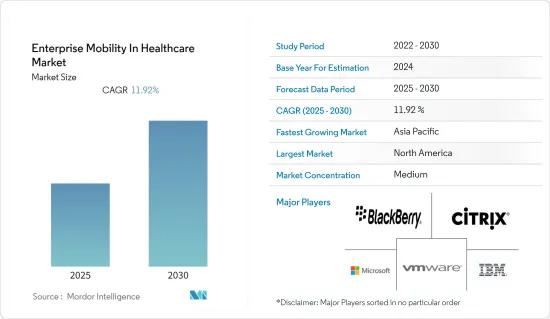
|
시장보고서
상품코드
1639444
의료 분야의 엔터프라이즈 모빌리티 시장 전망 : 시장 점유율 분석, 산업 동향, 성장 예측(2025-2030년)Enterprise Mobility In Healthcare - Market Share Analysis, Industry Trends & Statistics, Growth Forecasts (2025 - 2030) |
||||||
의료 분야의 엔터프라이즈 모빌리티 시장은 예측 기간 동안 연평균 성장율(CAGR) 11.92%를 기록할 전망입니다.

주요 하이라이트
- 의료 분야는 모바일 기술의 발전으로 인해 괄목할 만한 변화를 목격하고 있습니다. 개인 정보 보호 및 보안과 관련된 우려가 이전에 비해 효과적으로 해결되면서 엔터프라이즈 모빌리티 관리(EMM)가 의료 업계에서 크게 채택되고 있습니다.
- 모바일 디바이스가 인터넷, 기업 데이터 및 기타 다양한 정보에 액세스하는 데 선호되는 매체, 지속적인 비용 절감 압박, 수많은 의료 시설에서 개인 소유 디바이스(BYOD)가 증가하는 추세와 같은 요인이 시장 성장을 주도하고 있습니다.
- 모바일 디바이스(태블릿, 스마트폰, 노트북) 관리, 용도, 정보, 원격 지원 등 다양한 서비스가 엔터프라이즈 모빌리티 관리 솔루션의 일부로 제공되어 이러한 문제를 해결하고 신속하고 향상된 의사 결정, 치료 개선, 재입원 감소, 생산성 향상, 정확성 제고, 시간 및 비용 절감 등의 효과를 제공합니다.
- 의료 시스템에 EMM을 배포하면 기존의 환자 기록 관리 방식과 같은 문제를 해결할 수 있습니다. EMM을 사용하면 처방전, 검사 결과, 병력, 약품 등의 의료 기록을 종이 없는 방식으로 저장할 수 있습니다. 이를 통해 환자 건강 기록에 빠르고 쉽게 액세스할 수 있어 응급 상황에서 의사가 환자의 병력을 빠르게 확인하고 정보를 쉽게 업데이트할 수 있습니다.
- 그러나 인증된 소스에만 민감한 정보에 대한 액세스 권한을 부여하는 ID 및 액세스 관리(IAM)와 관련된 문제는 상당히 까다로울 수 있으며 보안 위험을 초래할 수 있습니다. 또한 의료 업계에서 전문가들의 원격 환자 모니터링 시스템 채택이 증가함에 따라 예측 기간 동안 의료 시장의 엔터프라이즈 모빌리티에 대한 수요 증가가 촉진될 것으로 예상됩니다.
- 의료 시스템에서 스마트폰과 태블릿의 채택 증가, 환자 중심의 모빌리티 애플리케이션에 대한 관심 증가, 의료 솔루션의 품질을 향상시키는 고급 연결성, 모빌리티 솔루션의 비용 효율성 향상으로 워크플로우 간소화, 모빌리티 솔루션 채택을 강화하는 간호 인력 및 의사 부족, 2G 및 3G와 같은 무선 네트워크의 강력한 보급이 이 시장의 성장을 촉진하는 요인입니다. 그러나 데이터 보안 문제, 모바일 컴퓨터의 짧은 배터리 수명, 표준 통신 프로토콜 및 환급 정책의 부재, 인프라 및 비용 문제는 의료 분야 모빌리티 솔루션 시장의 성장에 큰 걸림돌로 작용하고 있습니다.
- 의료 분야 모빌리티 솔루션 시장은 제품 및 서비스, 용도, 최종 사용자를 기준으로 세분화됩니다. 제품 및 서비스를 기준으로 시장은 모바일 기기, 모바일 애플리케이션, 엔터프라이즈 플랫폼으로 세분화됩니다. 모바일 디바이스 시장은 모바일 컴퓨터, 무선 주파수 식별(RFID) 스캐너, 바코드 스캐너 등을 포함합니다. 용도에 따라 시장은 환자 치료 관리, 운영 관리, 인력 관리로 분류됩니다. 최종 사용자에 따라 시장은 지불자, 공급자, 환자로 나뉩니다.
의료 분야의 엔터프라이즈 모빌리티 시장 동향
의료계에서 정보 액세스 매체로서 스마트폰 채용 확대
- 현재 의료 서비스 제공업체는 모바일 기기를 사용하거나 클라우드 서비스에 액세스하여 일상적인 업무를 수행합니다. 업계가 엔터프라이즈 모빌리티로 전환함에 따라 직원들은 개인 기기를 사용하면서 생산성을 높일 수 있게 되었습니다.
- 스마트폰의 확산으로 다양한 임베디드 센서가 탑재되어 있어 빠르고 쉽게 환자를 평가할 수 있게 되었습니다. 예를 들어, 의료진은 헬스케어 앱을 통해 환자의 스마트폰 데이터에 액세스하여 심박수, 혈압, 혈당 수치 등을 측정할 수 있습니다.
- 아시아태평양 지역의 높은 성장세는 첨단 모바일 기술의 채택이 증가하고 효율적인 의료 서비스 전달 시스템에 대한 수요가 증가했기 때문일 수 있습니다. 또한, 이 지역의 탄탄한 의료 인프라, 기술 발전, 정부의 지원 이니셔티브도 시장 성장에 기여하고 있습니다. 또한, 모바일 기술이 지속적으로 발전하고 디지털 건강에 대한 관심이 높아짐에 따라 모바일 건강 앱의 성장세가 두드러지고 있습니다.
- 게다가 모바일 건강 앱은 몸이 아플 때 직접 병원을 방문할 필요성을 없애줍니다. 엔터프라이즈 모빌리티 관리(EMM) 의료 솔루션은 환자와 의료진이 채팅, 메시지, 영상 통화를 통해 원격으로 편리하게 진료를 받을 수 있는 방법을 제공합니다. 원격 환자 진료는 의료 서비스 접근성과 의사 대 환자 비율이 낮은 국가와 주에 도움이 됩니다.
- 모바일 애플리케이션, 사물 인터넷(IoT), 웨어러블 디바이스는 API를 사용하여 다른 애플리케이션 및 시스템과 상호 작용합니다. 실시간 API 기반 통합을 통해 이동 중에도 위치, 속도 및 기타 매개변수를 모니터링하는 API 중심 앱을 만들 수 있습니다.
- 실시간 애플리케이션 통합은 앱 간의 데이터 흐름을 실시간으로 지원하고 PC, 노트북, 기타 핸드헬드 디바이스 등 다양한 플랫폼에서 데이터를 동기화할 수 있도록 도와줍니다. 예를 들어, Cisco에 따르면 2030년까지 5,000억 대의 디바이스가 인터넷에 연결될 것으로 예상됩니다.
- 지역적으로 높은 확장은 첨단 모바일 기술의 채택 증가와 효율적인 의료 서비스 전달 시스템에 대한 수요 증가에 기인할 수 있습니다. 또한, 이 지역의 탄탄한 의료 인프라, 기술 발전, 정부의 지원이 시장 성장에 기여하고 있습니다. 또한, 모바일 기술이 지속적으로 발전하고 디지털 건강에 대한 관심이 높아짐에 따라 모바일 의료 시장은 더욱 성장하고 있습니다.
북미가 시장에서 큰 점유율을 차지
- 북미는 의료 분야 엔터프라이즈 모빌리티 시장에서 상당한 점유율을 차지하고 있습니다. 또한 이 지역은 시장에서 활동하는 업체들에게 강력한 발판을 마련하고 있습니다. Cisco Systems, Inc., IBM Corporation, Microsoft Corporation, BlackBerry Limited, Vmware, Inc. 등이 시장 성장에 기여하고 있습니다. 이 지역에서 활동하는 공급업체들은 디지털 혁신 솔루션을 더욱 개선하기 위해 협력하고 있습니다.
- 디지털 의료에 대한 정부의 지원, 더 나은 의료 서비스에 대한 수요 증가, 환자 안전 및 환자 치료에 관한 엄격한 규제, BYOD(Bring-Your-Own-Device)의 확산과 같은 요인이 이 지역의 의료 엔터프라이즈 모빌리티 시장의 성장을 주도하고 있습니다.
- IBM에 따르면 80% 이상의 이해관계자가 스마트폰이 조만간 의료 시스템의 필수적인 부분이 될 것이라고 생각합니다. 따라서 의료 시설에서 모바일 디바이스의 수가 증가함에 따라 아태지역에서 BYOD 도입이 증가할 것으로 예상됩니다. 지난 몇 년 동안 BYOD는 임상시험과 의료 현장에서 환자의 모바일 기기를 구현할 수 있는 의료 환경의 선도적인 접근 방식으로 자리 잡았습니다. 개인정보 보호에 중요한 정보에 액세스하기 위한 스마트폰과 태블릿의 채택은 예측 기간 동안 이 지역의 시장을 주도할 것으로 예상됩니다.
- 또한 이 나라의 의료 지출도 시장 성장을 견인하고 있습니다. 미국 노동 통계국에 따르면 이 부문은 미국 근로자의 약 11%를 고용하고 있습니다. 이러한 통계는 이 지역의 시장 성장 잠재력이 무궁무진하다는 것을 강조합니다.
- 지역적으로 높은 성장세는 첨단 모바일 기술의 채택이 증가하고 효율적인 의료 서비스 전달 시스템에 대한 수요가 증가했기 때문일 수 있습니다. 이 지역의 탄탄한 의료 인프라, 기술 발전, 정부의 지원은 시장 번영에 더욱 기여했습니다. 또한, 모바일 기술이 지속적으로 발전하고 디지털 건강에 대한 관심이 높아짐에 따라 시장 규모도 더욱 커지고 있습니다.
의료 분야의 엔터프라이즈 모빌리티 개요
의료 분야의 엔터프라이즈 모빌리티 시장은 적당한 경쟁을 갖고 있으며, VMWare Inc., Citrix Systems Inc., IBM Corporation, Microsoft Corporation, SAP SE, Symantec Corporation 등 주요 기업들이 지속적으로 혁신을 추진하고 있습니다. 이러한 기업들은 의료 서비스 제공업체의 요구를 충족하고 경쟁력을 유지하기 위해 정기적으로 새로운 제품을 출시하고 있습니다.
2022년 2월, 사물인터넷(IoT) 솔루션 및 글로벌 IoT 서비스형 커넥티비티(IoT CaaS) 분야의 글로벌 리더인 코레 그룹 홀딩스는 비즈니스 모빌리티 파트너스와 SIMON IoT를 인수했습니다. 업계를 선도하는 이 두 모빌리티 솔루션 제공업체는 의료 및 생명과학 산업에서 KORE Group Holdings의 서비스와 솔루션을 확장하기 위해 인수되었습니다. 이러한 전략적 움직임은 헬스케어 분야에서 모빌리티 솔루션의 중요성이 커지고 있으며, 이 분야에서 종합적인 서비스를 제공하고자 하는 의지를 보여줍니다.
기타 혜택
- 엑셀 형식 시장 예측(ME) 시트
- 3개월간의 애널리스트 지원
목차
제1장 서론
- 조사의 전제조건과 시장 정의
- 조사 범위
제2장 조사 방법
제3장 주요 요약
제4장 시장 인사이트
- 시장 개요
- 업계의 매력도 - Porter's Five Forces 분석
- 공급기업의 협상력
- 소비자의 협상력
- 신규 진입업체의 위협
- 경쟁 기업간 경쟁 관계
- 대체품의 위협
- 시장에 대한 COVID-19의 영향 평가
제5장 시장 역학
- 시장 성장 촉진요인
- 인터넷, 기업 데이터 및 기타 다양한 정보에 대한 액세스 수단으로 선호되는 모바일 장치의 성장
- 의료 분야의 BYOD 동향의 고조
- 시장의 과제
- 도입 비용의 높이와 직원의 수용성의 부족
제6장 시장 세분화
- 솔루션별
- 모바일 디바이스 관리
- 모바일 애플리케이션 관리(MAM)
- 모바일 컨텐츠 관리(MCM)
- 아이덴티티 액세스 관리(IAM)
- 지역별
- 북미
- 유럽
- 아시아
- 라틴아메리카
- 중동 및 아프리카
제7장 경쟁 구도
- 기업 프로파일
- BlackBerry Limited
- Vmware Inc.
- Citrix Systems Inc.
- IBM Corporation
- Microsoft Corporation
- Mobile Iron Inc.
- SAP SE
- Soti Inc.
- Symantec Corporation
- Ventraq Corporation
제8장 투자 분석
제9장 미래 전망
HBR 25.02.17The Enterprise Mobility In Healthcare Market is expected to register a CAGR of 11.92% during the forecast period.

Key Highlights
- The healthcare sector is witnessing a remarkable transformation due to mobile technology advancements. With the concerns associated with privacy and security being met effectively compared to earlier, enterprise mobility management (EMM) is witnessing significant adoption in the healthcare industry.
- Factors such as mobile devices being the preferred medium of accessing the internet, enterprise data, and various other information, continuous pressure to cut costs, and the rising trend of bring-your-own-device (BYOD) across numerous healthcare facilities are driving the market growth.
- Various services such as management of mobile devices (tablets, smartphones, or laptops), applications, information, and remote support are provided as a part of enterprise mobility management solutions in addressing the challenges and providing quick and improved decision making, improved treatment, and reduced readmissions, increased productivity, higher accuracy, time and cost-saving.
- The deployment of EMM in healthcare systems enables tackling challenges, such as the traditional way of managing patient records. EMM enables the storage of health records, like prescriptions, lab results, medical history, medications, and more, in a paperless way. This allows quick and easy access to patient health records, allowing the physicians to quickly check a patient's background during emergencies and provide easy information updates.
- However, issues about identity and access management (IAM), which involves granting access to sensitive information only to authenticated sources, could be quite challenging and could pose a security risk. Additionally, the growing adoption of remote patient monitoring systems in the healthcare industry by professionals is expected to fuel the demand growth for Enterprise Mobility in Healthcare Market during the forecast period.
- Growing adoption of smartphones and tablets in healthcare systems, rising focus on patient-centric mobility applications, advanced connectivity to enhance the quality of healthcare solutions, better cost efficiency of mobility solutions resulting in a streamlined workflow, shortage of nursing staff and doctors enhancing the adoption of mobility solutions, and robust penetration of wireless networks such as 2G and 3G are factors fuelling the growth of this market. However, data security issues, short battery life of mobile computers, lack of standard communication protocols and reimbursement policies, and infrastructural and cost issues pose major challenges to the growth of the healthcare mobility solutions market.
- The healthcare mobility solutions market is segmented on the basis of products and services, applications, and end users. Based on products and services, the market is segmented into mobile devices, mobile applications, and enterprise platforms. The mobile devices market covers mobile computers, radio frequency identification (RFID) scanners, barcode scanners, and others. On the basis of applications, the market is classified into patient care management, operations management, and workforce management. By end users, the market is divided into payers, providers, and patients.
Enterprise Mobility In Healthcare Market Trends
Growing Adoption of Smartphones In Healthcare Industry As The Preferred Medium of Accessing Information
- In the current scenario, healthcare providers conduct their day-to-day businesses using mobile devices or accessing cloud services. The shift in the industry towards enterprise mobility has resulted in increased employee productivity while using their own devices.
- The proliferation of smartphones has enabled quick and easy patient appraisals due to the presence of different embedded sensors. For example, healthcare providers can access the data from patients' smartphones with healthcare apps to measure heart rates, blood pressure, glucose levels, and more.
- High regional expansion can be attributed to the increasing adoption of advanced mobile technologies and the rising demand for efficient healthcare delivery systems. Additionally, the region's robust healthcare infrastructure, technological advancements, and supportive government initiatives have further contributed to the flourishing market. Moreover, with the continuous advancement of mobile technologies and the growing focus on digital health.
- Besides, mobile health apps eradicate the need to visit a doctor during sickness physically. Eneterpise mobility management (EMM) healthcare solutions offer patients and healthcare providers a convenient way to access care remotely through chat, messages, and video calling. Remote patient care benefits countries and states with low access to healthcare and doctor-to-patient ratios.
- Mobile applications, the Internet of Things (IoT), and wearable devices use APIs to interact with other applications and systems. With real-time API-driven integration, one can make API-centric apps that monitor location, speed, and other parameters on the go.
- Real-time application integration helps data flow between apps in real time and data synchronization across numerous platforms, such as PCs, laptops, and other handheld devices. For instance, According to Cisco, 500 billion devices are expected to be connected to the Internet by 2030
- High regional expansion can be attributed to the increasing adoption of advanced mobile technologies and the rising demand for efficient healthcare delivery systems. Additionally, the region's robust healthcare infrastructure, technological advancements, and supportive government initiatives have further contributed to the flourishing market. Moreover, with the continuous advancement of mobile technologies and the growing focus on digital health.
North America Holds Major Share in the Market
- North America holds a significant share of the healthcare enterprise mobility market. Moreover, the region has a strong foothold on players operating in the market. Some include Cisco Systems, Inc., IBM Corporation, Microsoft Corporation, BlackBerry Limited, and Vmware, Inc., contributing to the market's growth. The vendors operating in the region are collaborating to improve digital transformation solutions further.
- Factors such as government initiatives for digital health, growing demand for better healthcare services, strict regulations regarding patient safety and patient care, and the proliferation of bring-your-own-device (BYOD) drive the growth of the healthcare enterprise mobility market in the region.
- According to IBM Corporation, over 80% of the stakeholders feel smartphones will become an integral part of the healthcare system shortly. Hence, with the growing number of mobile devices in healthcare facilities, the adoption of BYOD is expected to increase in the region. Over the past few years, BYOD has become a leading approach in healthcare settings that allows the implementation of patients' mobile devices in clinical trials and healthcare practice. The adoption of smartphones and tablets for accessing privacy-critical information is expected to drive the region's market over the forecast period.
- Furthermore, healthcare spending in the country is also driving market growth. According to the Bureau of Labor Statistics, the sector employs about 11% of American workers. Such statistics highlight the brimming potential for market growth in the region.
- High regional expansion can be attributed to the increasing adoption of advanced mobile technologies and the rising demand for efficient healthcare delivery systems. The region's robust healthcare infrastructure, technological advancements, and supportive government initiatives have further contributed to the flourishing market. Moreover, with the continuous improvement of mobile technologies and the growing focus on digital health.
Enterprise Mobility In Healthcare Industry Overview
The healthcare enterprise mobility market is moderately competitive, with key players including VMWare Inc., Citrix Systems Inc., IBM Corporation, Microsoft Corporation, SAP SE, and Symantec Corporation consistently engaged in innovation. These companies regularly introduce new products to meet the needs of healthcare providers and maintain their competitive edge. Some recent market developments include:
In February 2022, KORE Group Holdings, Inc., a global leader in Internet of Things ("IoT") solutions and worldwide IoT Connectivity-as-a-Service ("IoT CaaS"), acquired Business Mobility Partners and SIMON IoT. These two industry-leading mobility solution providers were acquired with the intention of expanding KORE Group Holdings' services and solutions within the healthcare and life sciences industries. This strategic move demonstrates the growing importance of mobility solutions in healthcare and the drive to offer comprehensive services in this sector.
Additional Benefits:
- The market estimate (ME) sheet in Excel format
- 3 months of analyst support
TABLE OF CONTENTS
1 INTRODUCTION
- 1.1 Study Assumptions and Market Definition
- 1.2 Scope of the Study
2 RESEARCH METHODOLOGY
3 EXECUTIVE SUMMARY
4 MARKET INSIGHTS
- 4.1 Market Overview
- 4.2 Industry Attractiveness - Porter's Five Forces Analysis
- 4.2.1 Bargaining Power of Suppliers
- 4.2.2 Bargaining Power of Consumers
- 4.2.3 Threat of New Entrants
- 4.2.4 Intensity of Competitive Rivalry
- 4.2.5 Threat of Substitute Products
- 4.3 Assessment of the Impact of COVID-19 on the Market
5 MARKET DYNAMICS
- 5.1 Market Drivers
- 5.1.1 Growth of Mobile Devices as the Preferred Medium of Accessing Internet, Enterprise Data, and Various Other Information
- 5.1.2 Rising BYOD Trend across Healthcare
- 5.2 Market Challenges
- 5.2.1 High Cost of Implementation, Coupled with Lack of Acceptability among Employees
6 MARKET SEGMENTATION
- 6.1 By Solution
- 6.1.1 Mobile Device Management
- 6.1.2 Mobile Application Management (MAM)
- 6.1.3 Mobile Content Management (MCM)
- 6.1.4 Identity and Access Management (IAM)
- 6.2 By Geography
- 6.2.1 North America
- 6.2.2 Europe
- 6.2.3 Asia
- 6.2.4 Latin America
- 6.2.5 Middle East and Africa
7 COMPETITIVE LANDSCAPE
- 7.1 Company Profiles
- 7.1.1 BlackBerry Limited
- 7.1.2 Vmware Inc.
- 7.1.3 Citrix Systems Inc.
- 7.1.4 IBM Corporation
- 7.1.5 Microsoft Corporation
- 7.1.6 Mobile Iron Inc.
- 7.1.7 SAP SE
- 7.1.8 Soti Inc.
- 7.1.9 Symantec Corporation
- 7.1.10 Ventraq Corporation













